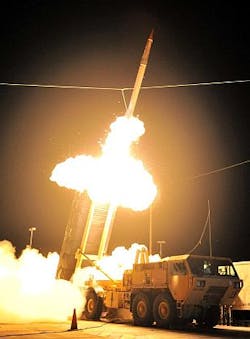Missile Defense Agency looks to Lockheed Martin for technology upgrades to THAAD
REDSTONE ARSENAL, Ala., 6 Feb. 2012. Officials of the U.S. Missile Defense Agency (MDA) at Redstone Arsenal, Ala., are looking to the Lockheed Martin Corp. Space Systems segment in Sunnyvale, Calif., provide systems upgrades and technology insertion for the Terminal High Altitude Area Defense (THAAD)ballistic missile-defense system under terms of a potential $515.4 million contract announced Friday. Lockheed Martin is the THAAD prime contractor.
THAAD is an MDA system designed to shoot down short-, medium-, and intermediate-range ballistic missile warheads as these weapons are in their final phases of flight. THAAD weapons, which are precision-guided to hit their targets, rely on kinetic energy to destroy incoming ballistic missile warheads.
The contract calls for Lockheed Martin to develop, integrate, and test upgrades to the THAAD system and its components, including the THAAD interceptor, fire-control system, communications, launcher, and AN/TPY-2 radar.
Lockheed Martin will concentrate on systems upgrades and technology insertion to deal with THAAD communications, obsolescence mitigation, flight and ground testing, and spiral development. Lockheed Martin also will improve THAAD's integration into the U.S. ballistic missile defense system architecture by developing unifying missile defense functions.
Lockheed Martin started developing the THAAD system in 1992, and first tested the system three years later. The first THAAD tests that hit their targets were in 1999, after the first six tests missed their targets. THAAD missiles, which have a maximum range of about 125 miles, are expected to hit incoming ballistic missile warheads as high as 93 miles above the Earth's surface.
THAAD uses an X-Band radar from the Raytheon Co. Integrated Air Defense segment in Andover, Mass. Other key subcontractors are Boeing, Aerojet, Rocketdyne, Honeywell, BAE Systems, and MiltonCAT.
The first deployed THAAD battery was activated in mid-2008 at Fort Bliss, Texas. In 2009 a THAAD unit and a sea-based radar were deployed to Hawaii to defend against a possible North Korean attack.
Lockheed Martin will coordinate work for the contract in Sunnyvale, Calif., and Huntsville, Ala., and should be finished by early 2017. For more information contact Lockheed Martin Space Systems online at www.lockheedmartin.com/us/ssc, or the Missile Defense Agency at www.mda.mil.
